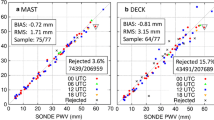Abstract
The measurement of atmospheric water vapor (WV) content and variability is important for meteorological and climatological research. A technique for the remote sensing of atmospheric WV content using ground-based Global Positioning System (GPS) has become available, which can routinely achieve accuracies for integrated WV content of 1–2 kg/m2. Some experimental work has shown that the accuracy of WV measurements from a moving platform is comparable to that of (static) land-based receivers. Extending this technique into the marine environment on a moving platform would be greatly beneficial for many aspects of meteorological research, such as the calibration of satellite data, investigation of the air-sea interface, as well as forecasting and climatological studies. In this study, kinematic precise point positioning has been developed to investigate WV in the Arctic Ocean (80°–87°N) and annual variations are obtained for 2008 and 2012 that are identical to those related to the enhanced greenhouse effect.
Similar content being viewed by others
References
Baker H C. 1998. GPS water vapour estimation for meteorological applications [dissertation]. United Kingdom: University of Nottingham, 416
Bevis M, Businger S, Herring T A, et al. 1992. GPS meteorology: remote sensing of atmospheric water vapor using the global positioning system. Journal of Geophysical Research, 971(D14): 15787–15801
Brunner F K, Welsch W M. 1993. Effect of the troposphere on GPS measurements. GPS World, 4(1): 42–46
Dodson A H, Baker H C. 1998. The accuracy of GPS water vapour estimation. Proceedings of the 1998 National Technical Meeting of the Institute of Navigation, California, 21–23
Elgered G, Rönnäng B, Winberg E, et al. 1985. Satellite-Earth Range Meaurements: 1. Correction of the Excess Path Length Due to Atmospheric Water Vapour by Ground Based Microwave Radiometry. Research Report No. 147. Gothenburg, Sweden: Department of Radio and Space Science, Chalmers University of Technology
Kouba J, Héroux P. 2001. Precise point positioning using IGS orbit and clock products. GPS Solutions, 5(2): 12–28
Rocken C, Van Hove T, Johnson J, et al. 1995. GPS/STORM-GPS sensing of atmospheric water vapor for meteorology. Journal of Atmospheric and Oceanic Technology, 12(3): 468–478
Zhang Xiaohong, Andersen O B. 2006. Surface ice flow velocity and tide retrieval of the Amery ice shelf using precise point positioning. Journal of Geodesy, 80(4): 171–176
Zumbergre J F, Heflin M B, Jefferson D C, et al. 1997. Precise point positioning for the efficient and robust analysis of GPS data from large networks. Journal of Geophysical Research, 102(B3): 5005–5017
Author information
Authors and Affiliations
Corresponding author
Additional information
Foundation item: Chinese Polar Environment Comprehensive Investigation and Assessment Programmes under contract Nos CHINARE 2013-03-03 and CHINARE 2013-04-03; the National Oceanic Commonweal Research Project under contract No. 201105001; the National Natural Science Foundation of China under contract No. 41374043.
Rights and permissions
About this article
Cite this article
Luo, X., Zhang, T., Gao, J. et al. Estimation of annual variation of water vapor in the Arctic Ocean between 80°–87°N using shipborne GPS data based on kinematic precise point positioning. Acta Oceanol. Sin. 34, 1–4 (2015). https://doi.org/10.1007/s13131-015-0680-1
Received:
Accepted:
Published:
Issue Date:
DOI: https://doi.org/10.1007/s13131-015-0680-1




